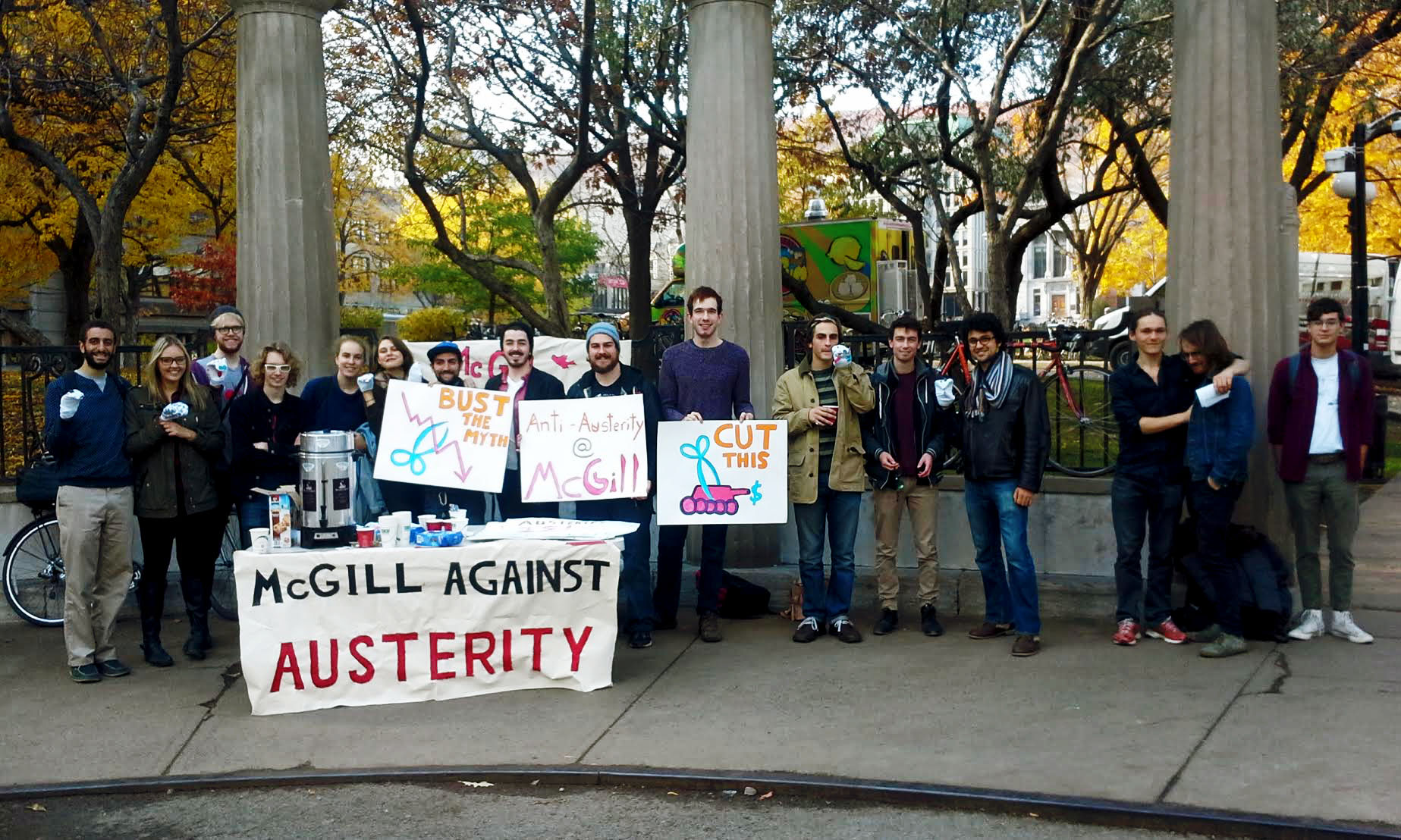Over a thousand demonstrators took to the streets on November 5 to protest the Quebec government’s austerity measures, joined by contingents of university students organized by student associations, including the Students’ Society of McGill University (SSMU). The demonstration also brought together the student associations within the Association pour une solidarité syndicale étudiante (ASSÉ) who were collectively striking for the occasion.
The McGill contingent was organized by McGill Against Austerity, a newly formed student group whose goal is to mobilize students, spread awareness about austerity, and increase McGill’s involvement in the movement. Around twenty McGill students gathered at the Roddick Gates at 12 p.m. to participate in the march.
SSMU VP External Emily Boytinck, who participated in the march, told The Daily, “I think it’s really important for McGill students to stand in solidarity with the rest of the Quebec student unions, the Quebec student movement, and the workers. We’re all fighting together against austerity.”
“[Austerity measures are occurring] while tax rates for corporations are being cut and taxes for the rich are not being increased. So essentially, what we are doing is having policies which benefit the rich at the expense of the poor,” Boytinck continued.
“Mass mobilization has always been key to changing government policy and changing power structures.”
At 12:45 p.m., the McGill group was joined by a Concordia contingent of around thirty students, chanting “Avec nous, dans la rue” (“Join us on the street”). The two contingents walked east along Sherbrooke, accompanied by several police cruisers and motorcycles. Ignoring police requests to use the sidewalk, protesters chanted: “Étudiants, travailleurs, même combat” (“Students, workers, same struggle”).
The McGill and Concordia contingents arrived at the general meeting point, the Montreal Science Centre, at 1:15 p.m. More contingents arrived shortly thereafter.
Adam Mackenzie, a U3 Political Science and History student, told The Daily that “mass mobilization has always been key to changing government policy and changing power structures. […] Today I hope to build toward that goal.”
Before the march began, three speeches were broadcast from a stereo system mounted on a truck. A union representative criticized the Quebec government’s claim that there isn’t enough money to reinvest in public services and education, in light of the multinational aerospace and transportation company Bombardier’s recent $1.3 billion bailout.
One student emphasized how austerity measures particularly affect women, in the form of closures of women’s status bureaus, the loss of public sector jobs mostly occupied by women, the closing of regional medical centres, and the cutting of affordable health services among other things.
“I believe that if people want to feel protected by their country, their government, the government should feed into social services.”
Nicola Protetch, a U2 Anthropology student, explained that she was attending the march because she believes austerity is the root of larger problems.
“Hopefully there is power in numbers and hopefully through that power, our voices will be heard, and the government [will start] looking at reform,” Protetch said.
The demands of protesters centred on reinvesting in public services and the public school system, and halting the budget cuts that disproportionately affect the most vulnerable people in society. “I believe that if people want to feel protected by their country, their government, the government should feed into social services,” Protetch explained.
The demonstrators left the Old Port at 1:45 p.m., marching up St. Laurent accompanied by dozens of police officers dressed in full riot gear.
The march was largely peaceful, save for some intervals of tension when police forces walked through the crowd or prevented demonstrators from marching in the direction they wanted to. At certain points, officers forced the march towards the north and east, away from Downtown.
The march ended after around two and a half hours.
Boytinck said, “There’s lots of different solutions to austerity. […] For example, by increasing the number of tax brackets, or raising the corporate tax rate, or really cracking down on corruption, […] gathering money from alternative sources, and not cutting valuable social programs.”
“Austerity is not a necessity; it’s a political choice,” she added.

